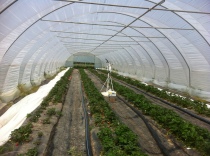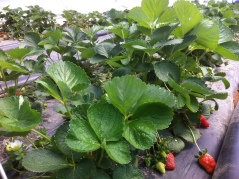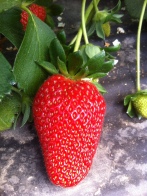Arkansas Strawberries!
Strawberries are making an appearance on farmers’ markets stands across the state and it’s clear the strawberry season has arrived once again in Arkansas. Because strawberries are usually grown outdoors, production in Arkansas is limited to only about 6 weeks a year leading to a highly anticipated local harvest season for consumers who seek high quality, locally grown berries. In at least one part of the state however, the strawberry harvest is in full swing and has been throughout the winter months. At the University of Arkansas Research and Extension Center in Fayetteville, strawberry harvest began in late November and will continue through the month of April according to David Dickey, the Horticulture Technician who conducts the day-to-day management of this strawberry production system. These strawberries are grown under a high tunnel which provides a protected environment for berries allowing local harvest in the off-season. The high tunnel system protects berries from frost and other weather related conditions that limit the season for berries grown outdoors. For the last three years, this high tunnel production system has produced strawberries from late November through April. It is a system that has the potential to revitalize the strawberry industry in Arkansas and help the local economy, according to Dr. Elena Garcia, the state’s Extension fruit and nut specialist and project leader.
Historically, Arkansas was one of the leading strawberry producing states. The strawberry industry arose in Arkansas in the late nineteenth and early twentieth centuries with favorable conditions for growing and marketing a first class berry. By 1926, growers located primarily in four Arkansas counties, Crawford, White, Benton, and Washington, had grown 15,000 acres of the berries.
In the early days, the railroad led to the emergence of Arkansas’s strawberry industry, but shipping of berries via refrigerated truck led to its decline, especially as it became possible to ship berries from areas of the country more suitable to the cultivation of strawberries, like California and Florida. Today, 89% of the strawberries grown in the U.S. come from California and 9% from Florida. The two states combined keep strawberries available in the grocery stores for most of the year. Still, Americans have an insatiable appetite for fresh strawberries and demand is so high that an equivalent of 15% of our annual crop is imported from Mexico. According to the Agricultural Marketing Resource Center, strawberry demand is expected to increase 7% a year for the next three years.
Today, Arkansas’ strawberry production is down to less than 1% of what it was during the Great Depression, and accounts for only a small fraction of the current national acreage. Ninety percent of the strawberries grown in Arkansas are sold in local markets. The rapid increase in the number of Farmers’ Markets in Arkansas and the region combined with increasing demand by consumers for local produce has created lucrative opportunities for growers of this highly sought after berry. Local strawberry growers are able to provide fresh and flavorful berries without spoilage and quality problems encountered when berries are shipped long distances.
Currently, most growers in Arkansas produce strawberries by plasticulture production, an annual hill training system in which freshly dug tips or plugs are fall planted in double rows at approximately 15,000 – 17,400 plants per acre on raised beds covered with black plastic mulch. With new advances in plastic mulch and protected culture technologies such as high tunnels, Arkansas growers have more opportunities to extend the strawberry season to meet the year-round demand while avoiding the need to ship long distances.
For the past three  years Dr. Elena Garcia and her group have investigated extended season strawberry production using plasticulture under high tunnels and have gained valuable experience and knowledge. The 2011 – 2012 high tunnel harvest season at the University of Arkansas, Fayetteville yielded up to 2.25 lb/plant (compared to 1.0 – 1.5 lb/plant field production) and provided harvest from late fall through winter and into spring using a high tunnel plasticulture production system.
years Dr. Elena Garcia and her group have investigated extended season strawberry production using plasticulture under high tunnels and have gained valuable experience and knowledge. The 2011 – 2012 high tunnel harvest season at the University of Arkansas, Fayetteville yielded up to 2.25 lb/plant (compared to 1.0 – 1.5 lb/plant field production) and provided harvest from late fall through winter and into spring using a high tunnel plasticulture production system.
Currently, high tunnel strawberry yield this season (2012 – 2013) is near 1 lb/plant and yield will continue to increase until harvest ends in May. The first harvest of these berries was on November 27th. The yield is still considered good, but this season’s yield is not expected to reach the 2011-12 yields of up to 2.25 lb/plant. A primary reason for this is the very late, cold spring compared to a very early, mild spring in 2012. Variability in pest levels and soil pH has also been noted in the tunnel and may be playing a role in yield.
is not expected to reach the 2011-12 yields of up to 2.25 lb/plant. A primary reason for this is the very late, cold spring compared to a very early, mild spring in 2012. Variability in pest levels and soil pH has also been noted in the tunnel and may be playing a role in yield.
With strawberry production down to a fraction of what it was in the 1920’s, the Arkansas strawberry market is ripe for revitalization. Extended season production using protected culture systems such as high tunnels could be the answer. Dr. Garcia’s group is working with these systems and towards a more vital and sustainable strawberry market for Arkansas and the surrounding region.

Reblogged this on Commercial Fruit and Nuts.